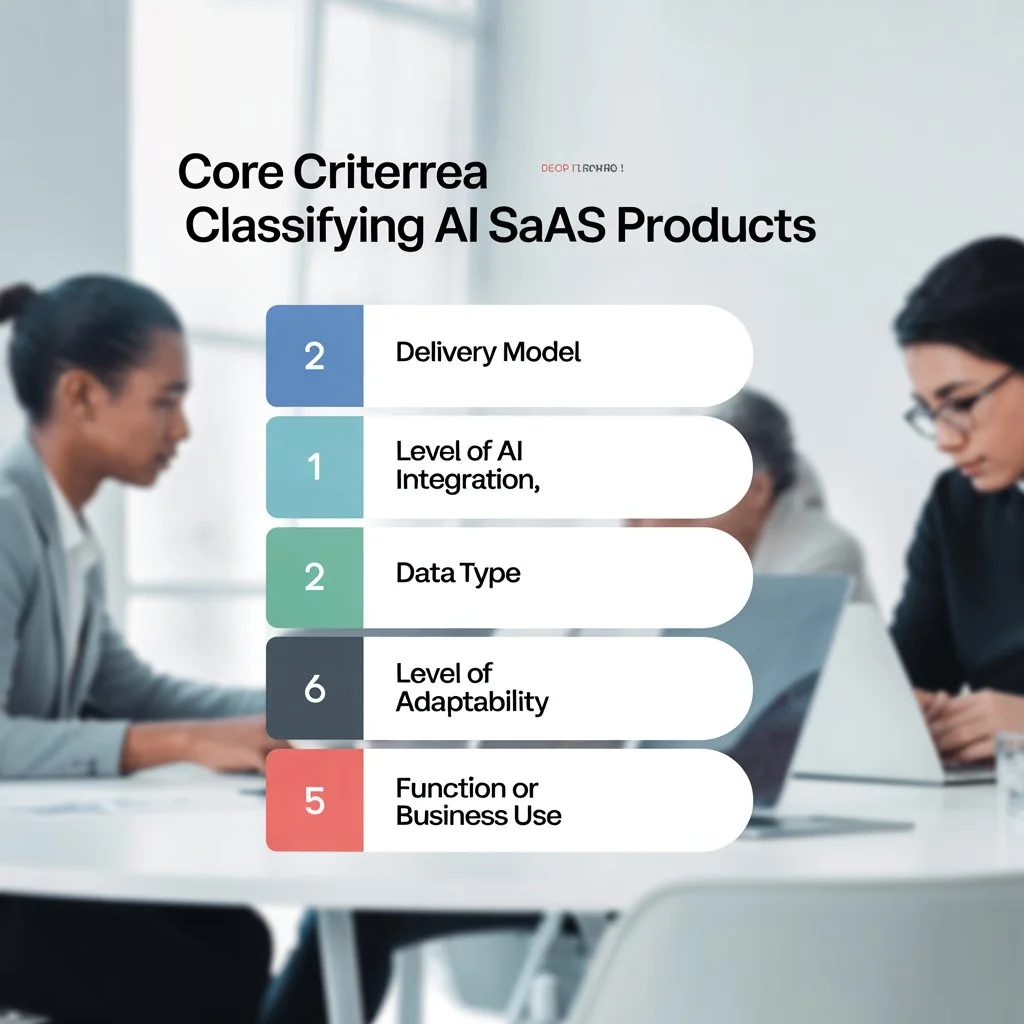Artificial Intelligence is now part of everyday business tools. From email to customer chat, many companies also use AI without realizing it. But every software that claims to use AI works in the same way.
Some tools follow simple rules. Others learn from your actions and improve over time. To make smart decisions, companies must understand how to group and compare these devices correctly.
According to MarketsandMarkets, the Global AI Saas market is expected to reach $371 billion in 2025. This is a large number of numbers, and it shows how fast this industry is growing.
But as AI software hits the market, confusion also increases. Many products call themselves “AI-Interacted”, even when they barely use real AI.
This is why businesses need a clear way to classify these devices. This helps them to know what they are getting, what the software can really do, and how useful it will be in real work.
What Is an AI SaaS Product?
AI SAAS refers to cloud-based software that includes artificial intelligence to perform specific tasks.
These tasks may include prediction, recommendation, classification, or pattern recognition. The key is that AI is baked into the application and delivered over the Internet.
Let’s say your company uses a chatbot to answer customer questions. If a Chatbot learns from previous conversations and provides better answers over time, it uses AI.
But if it just follows a script, it’s not true AI. Both can be called “AI tools”, but they are not the same.
Why Classifying AI SaaS Tools Matters

Companies often struggle to compare one AI product to another. A lack of consistent terminology and rating methods results in confusion.
What’s labeled as “AI-powered” might just be a rule-based workflow that doesn’t learn or adapt. That misrepresentation creates risks, especially when performance, ethics, or compliance are on the line.
Classification brings clarity. It enables more precise vendor selection. It allows investors to have a structured approach for assessing product capabilities.
And above all, it gives customers an understanding of what they’re buying. For the software engineers and product teams, these criteria enable them to plan for their roadmaps and understand where they stand in the competitive landscape.
In a recent survey PWC conducted, 73% of business leaders say they are concerned about how often “AI” is being used as a marketing buzzword.
There are a lot of tools in the market that are labelled as smart but do not learn, adapt, or improve. This mislabeling leads companies to use the wrong tool for the job they’re trying to do.
Classification brings order. It helps:
- Buyers choose wisely
- Developers explain clearly
- Investors understand value
- Teams pick tools that match their needs
Read Also: Ultimate Guide to Shein Influencer and Affiliate Programs: Grow, Earn, and Shine Online
Core Criteria to Classify AI SaaS Products

There are several ways to group AI SaaS tools. Below are the main factors you should look at when evaluating or describing these products.
1. Delivery Model: Public, Private, or Hybrid
This aspect focuses on where the AI model runs and how it is distributed. Public cloud products are available to all users with minimal configurations. Private distributions can offer better safety and adaptation. Hybrid models combine elements of both and provide flexibility.
Delivery type affects scalability, compliance, and latency. Industries with strict computer control may prefer a private or hybrid layout.
2. Level of AI Integration
Some platforms use AI only in a narrow function, say, fraud detection. Others embed AI throughout the system from user onboarding to automated reporting. The classification here can be defined as:
- Add-on AI: AI is a feature, not the core.
- Built-in AI: AI is part of the foundational architecture.
- AI-first: The entire experience revolves around machine learning or decision automation.
Understanding this tells you how critical AI is to the software’s value.
3. Data Type the Tool Handles
Some software uses clean, structured data like spreadsheets. Others process messy data like images, audio, or human speech. A few tools analyze data in real time. This is great for fast decisions, like fraud detection or live chat systems.
According to IBM, 80% of all data today is unstructured. So tools that can handle this type of information have a major advantage.
4. Level of Adaptability
This checks if the software can learn and change. Some tools follow set rules forever. Others update themselves based on new information. The most advanced systems learn while you use them.
Here’s a simple way to group them:
| Type | Learns over time? | Needs human input? |
| Rule-based system | No | Yes |
| Partially adaptive | Sometimes | Often |
| Fully adaptive | Yes | Rarely |
Choosing a higher-level system means better performance but also more testing and oversight.
5. Function or Business Use
Some AI SaaS products are made for marketing. Others help with sales, hiring, finance, or customer support. Grouping them by purpose makes it easier to compare.
For example, an AI hiring tool shouldn’t be judged the same way as a sales forecasting app. Their goals, users, and risks are completely different.
6. How Easy Is It to Understand AI Decisions
This is important for trust. If the software makes a prediction or takes an action, can you tell why it did that? Some AI models are simple and easy to follow. Others are complex and act like black boxes.
In industries with legal rules like insurance or healthcare, being able to explain AI decisions isn’t optional. It’s required by law in many regions.
7. Who Owns the Model?
Does the vendor own the AI model? Or does it use someone else’s system? Some products even let the buyer train and control the model.
Ownership affects cost, updates, security, and legal rights. Knowing this helps companies plan better for long-term use.
Classification Criteria Checklist
| Classification Dimension | Description | Importance Level |
| Delivery Model | Cloud-based vs. hybrid or private | High |
| AI Integration | Core vs. auxiliary | High |
| Data Type | Structured, unstructured, real-time | Medium |
| Autonomy | Static, semi-adaptive, fully adaptive | High |
| Industry Focus | General-purpose or domain-specific | Medium |
| Transparency | Explainable or black-box | Critical |
| Model Ownership | Proprietary vs. integrated | High |
Real Business Example:
Let’s say one company sells clothes online, and the other runs a medical clinic. Both want to use AI tools to help their staff save time.
The online store picks a product that uses AI to recommend clothes based on user clicks. It updates daily and works fast. Since there are no legal risks, explainability isn’t a big concern.
The clinic, however, needs an AI tool to manage patient bookings. It has to explain its decisions because mistakes can be serious. In this case, the clinic needs a system that prioritizes safety, control, and clarity, even if it’s slower.
Same technology type. Two different uses. And that’s why classification is so important.
Tips for Product Managers Evaluating AI SaaS Solutions
If you’re leading a product team, you need a structured way to assess AI vendors. Start by documenting your expectations across the seven criteria we discussed. Define must-haves and nice-to-haves. Then match them against the shortlisted tools.
For example, if you’re in HR tech and transparency matters, rule out tools that operate like black boxes. If you’re in digital marketing and speed is everything, prioritize platforms with real-time learning capabilities.
Always request a whitepaper or technical brief during the evaluation. If the vendor cannot explain how their model behaves under different data scenarios, consider that a red flag.
The Role of Regulation in Classification
As governments catch up with AI technology, classifications are likely to become regulatory requirements. The EU’s AI Act and similar initiatives push for risk-based labeling. High-risk applications (such as biometric surveillance or credit scoring) will need strict classification and compliance audits.
Being ahead of these frameworks means your company won’t scramble to reclassify when the law changes.
Questions to Ask Before You Commit
To avoid making the wrong choice, ask these key questions:
- How important is AI to the software’s main features?
- Does it use real learning or just follow preset steps?
- What kind of data does it work with?
- Can it update itself over time?
- Is it built for our type of business?
- Can we see how it makes decisions?
- Who owns the model and data?
Getting answers to these will help you avoid tools that sound fancy but don’t meet your needs.
Final Words
AI Saas products change how work is done. But in order to get real results, companies must learn to sort through the noise. The AI Saas product classification criteria explained here make the process clear.
By looking at things like how the tool is distributed, how it uses data, how much it learns, and how clear it explains itself, companies can make smarter choices.
This is not just about finding new software. It’s about making sure the tools you use match your goals – and don’t cause more problems than they solve.
As the AI market grows, the ability to judge tools fairly and obviously will be what sets smart companies apart.
FAQS
What are AI SaaS products?
AI SaaS products are cloud-based software tools that use artificial intelligence to automate tasks, make predictions, or support decision-making.
How to make a SaaS with AI?
To build a SaaS with AI, combine a web-based software platform with machine learning models trained on relevant data to solve specific problems.
What are the 4 types of AI software?
The four types include reactive machines, limited memory systems, theory of mind AI (not yet fully developed), and self-aware AI (still theoretical).
What is the difference between SaaS and AI?
SaaS is a delivery model for software over the internet, while AI is the technology that enables machines to simulate human intelligence.
Is AI replacing SaaS?
No, AI is not replacing SaaS—it is enhancing it by adding intelligent features like automation, recommendations, and predictions.
How to use AI in SaaS sales?
Use AI in SaaS sales to score leads, personalize outreach, forecast revenue, and automate customer responses.
How much does it cost to build an AI SaaS?
Building an AI SaaS can cost between $30,000 and $250,000+, depending on features, data requirements, and team size.




